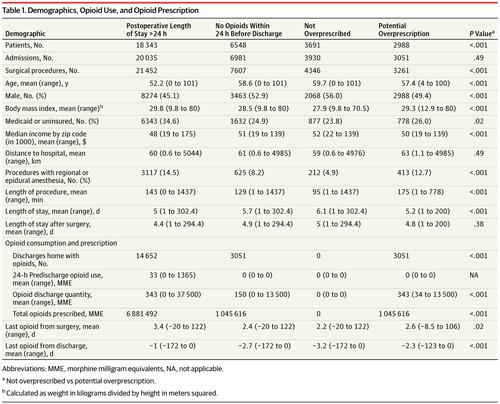JAMA Surgery ( IF 15.7 ) Pub Date : 2018-02-01 , DOI: 10.1001/jamasurg.2017.4859 Eric Y. Chen 1, 2 , Andrew Marcantonio 2 , Paul Tornetta 1

|
Importance The United States is experiencing an opioid abuse epidemic. Opioid overprescription by physicians may contribute to this epidemic.
Objectives To determine if there was a correlation between a postoperative patient’s 24-hour predischarge opioid use and the amount of opioids prescribed at hospital discharge and to determine the number of patients who used no opioids prior to discharge but were still prescribed opioids after hospital discharge.
Design, Setting, and Participants This cross-sectional study performed a retrospective record review of 18 343 postoperative patients at Boston Medical Center and Lahey Hospital and Medical Center–Burlington Campus who were discharged home after a postoperative inpatient admission of at least 24 hours. Data collection spanned from May 22, 2014, to June 30, 2016, in the Boston Medical Center data set and from March 23, 2015, to September 7, 2016, in the Lahey Hospital and Medical Center–Burlington Campus data set.
Exposures Surgery requiring a postoperative inpatient hospital stay longer than 24 hours.
Main Outcomes and Measures The main outcome measures were the patient’s 24-hour predischarge opioid use and the total quantity of opioids prescribed at hospital discharge. Potential overprescription was defined as the number of patients who used no opioids in the 24 hours prior to hospital discharge but were still prescribed opioids after hospital discharge.
Results Among the 18 343 patients (10 069 women and 8274 men; mean age, 52.2 years) who underwent 21 452 surgical procedures, there was wide variation in the amount of opioids prescribed at hospital discharge given a postoperative patient’s 24-hour predischarge opioid use. A total of 6548 patients (35.7%) used no opioids in the 24 hours prior to hospital discharge; however, 2988 of these patients (45.6%) were prescribed opioids at hospital discharge, suggesting potential overprescription. Services that had the highest rates of potential overprescription (obstetrics [adjusted odds ratio (AOR), 3.146; 95% CI, 2.094-4.765] and gynecology [AOR, 2.355; 95% CI, 1.663-3.390], orthopedics [AOR, 0.943; 95% CI, 0.719-1.242], and plastic surgery [AOR, 0.733; 95% CI, 0.334-1.682]) generally had the highest rates of patients still using opioids at hospital discharge. Pediatric surgery was the only service that did not have any cases of potential overprescription (AOR, 2.09 × 10−7; 95% CI, 0.000-0.016).
Conclusions and Relevance Opioids are not regularly prescribed in a patient-specific manner to postoperative patients. Potential opioid overprescription occurs regularly after surgery among almost all surgical specialties.
中文翻译:

出院前24小时使用阿片类药物与出院中规定的阿片类药物量之间的相关性
重要性 美国正在经历阿片类药物滥用流行病。医生对阿片类药物的过度处方可能助长了这一流行病。
目的 确定术后患者24小时出院前使用阿片类药物与出院时处方的阿片类药物量之间是否存在相关性,并确定出院前未使用阿片类药物但出院后仍使用阿片类药物的患者人数。
设计,设置和参与者 这项横断面研究对波士顿医学中心,拉希医院和医学中心-伯灵顿校区的18343例术后患者进行了回顾性记录回顾,这些患者术后住院至少24小时后就出院了。数据收集的时间跨度为2014年5月22日至2016年6月30日,位于波士顿医学中心数据集中,而数据收集的时间跨度为2015年3月23日至2016年9月7日,位于Lahey医院和医学中心-伯灵顿校园数据集中。
暴露 手术要求术后住院时间超过24小时。
主要结果和措施 主要结果指标是患者出院前24小时使用阿片类药物和出院时处方的阿片类药物总量。潜在的处方过量定义为在出院前24小时内未使用阿片类药物但仍在出院后开出阿片类药物的患者人数。
结果 在接受21 452例外科手术的18 343例患者(10069例女性和8274例男性;平均年龄52.2岁)中,考虑到术后患者24小时出院前使用阿片类药物,出院时开出的阿片类药物处方量存在很大差异。出院前24小时内共有6548例患者(35.7%)未使用阿片类药物;然而,这些患者中有2988名(45.6%)在出院时开出了阿片类药物处方,表明潜在的处方过量。潜在超处方率最高的服务(妇产科[调整后的优势比(AOR),3.146; 95%CI,2.094-4.765]和妇科[AOR,2.355; 95%CI,1.663-3.390],骨科[AOR,0.943] ; 95%CI,0.719-1.242]和整形手术[AOR,0.733; 95%CI,0.334-1.682])通常在出院时仍使用阿片类药物的患者发生率最高。−7 ; 95%CI,0.000-0.016)。
结论与相关性 阿片类药物并非针对患者术后常规的针对患者的特定处方。在几乎所有的外科专科中,潜在的阿片类药物过量处方都会在手术后定期发生。











































 京公网安备 11010802027423号
京公网安备 11010802027423号